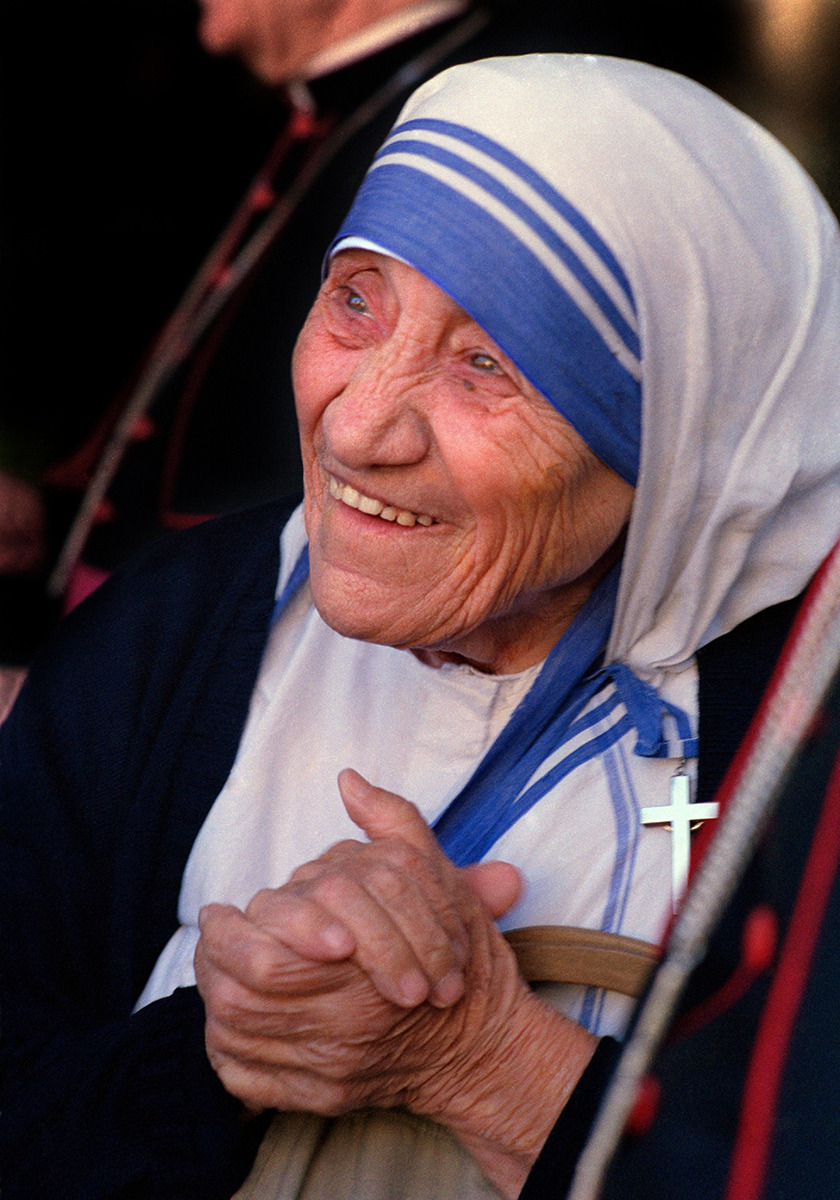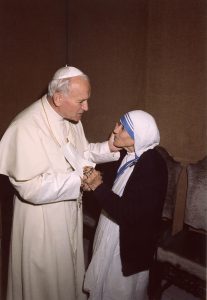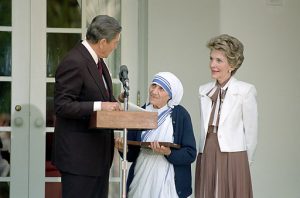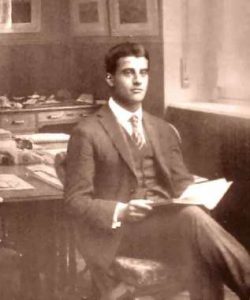
By Renae Kranz
Perhaps the most well-known modern-day saint in the world today was a tiny woman who lived in a poor country and cared for the least among us. She did not seek fame, but in many ways it found her anyway. She also found criticism from some because she did not do her work the way they thought she should. She did her work anyway.

The most difficult trial she faced was one that was unknown to the world until after her death: a spiritual absence of God that she felt in her life. Even in that darkness and trial, her love for God burned bright anyway.
St. Teresa of Calcutta, better known as Mother Teresa, faced challenges, loved God and served others. She gives us a beautiful example of putting the Lord’s will first in our lives even when it’s difficult to do.
Early influences
Teresa was born Gonxha (Agnes) Bojaxhiu in Skopje, North Macedonia (a European country north of Greece), to Albanian parents Nikola and Drane Bojaxhiu on August 26, 1910. She was the youngest of three children who lived a comfortable family life.
She received her first communion and was confirmed by the time she was 6 years old. By the time she was 8, life changed dramatically. Teresa’s father Nikola died suddenly, plunging the family into a dire financial situation, but her mother Drane held the family together, raising them with firmness and love. She had a profound influence on Teresa’s character and later her vocation. Her faith was also influenced by the Jesuit parish of the Sacred Heart where she was heavily involved.
As she grew through her teen years, Teresa was fascinated by the work of missionaries and their stories. In 1928 at 18, she left home for Ireland to join the Sisters of Loreto because of their institute where she could learn the English language and become a missionary. Once leaving her mother and sister that year, she would never see them again.
Teresa left Ireland after only one year to become a missionary at the Sisters of Loreto in Calcutta, India. She took her first vows in May of 1931 and took the name Sister Mary Teresa after St. Therese of Lisieux. She began teaching at the convent school, St. Mary school for girls. She became the principal of the school in 1944 and taught there for almost 20 years.
Teresa took her final vows on May 24, 1937. It was around this time that her religious sisters began calling her Mother Teresa. She was known as a prayerful woman, a hard worker, full of charity for others and great courage to do what others would not.
Hearing the cry of the poor
By September 1946, Mother Teresa was becoming deeply disturbed by the treatment of the poor in Calcutta. The misery, death and abandonment she witnessed became too much. On a train ride to Darjeeling, she heard the Lord calling her to a new way of serving Him. She felt his thirst for souls and for love, and it became the driving force of her life of service.
After two years of discernment, visions and interior discourse with the Lord, Mother Teresa was given permission to leave Loreto convent and establish the Missionaries of Charity on October 7, 1950, so she could serve the poorest of the poor in Calcutta. She went out every day into the streets to wash the sores of the sick, care for and nurse the dying, and pray with those who were invisible to the rest of the world. Over time, her former students began to join her in her work.
The first year of her new ministry was a difficult one. She had no income and had to beg for food and the supplies she needed. This holy woman experienced doubt during this time and deep loneliness, tempting her to consider going back to convent life. Kathryn Spink’s biography of Mother Teresa quotes her from this time of struggle.
“Our Lord wants me to be a free nun covered with the poverty of the cross. Today, I learned a good lesson. The poverty of the poor must be so hard for them. While looking for a home I walked and walked till my arms and legs ached. I thought how much they must ache in body and soul, looking for a home, food and health. Then, the comfort of Loreto [her former congregation] came to tempt me. ‘You have only to say the word and all that will be yours again,’ the Tempter kept on saying. … Of free choice, my God, and out of love for you, I desire to remain and do whatever be your Holy will in my regard. I did not let a single tear come.”

She quickly began to catch the attention of officials in Calcutta because of her work with the poor. They helped her open her first hospice in 1952, the Home of the Pure Heart, and made it free for the poor. People who came there were cared for and allowed to die in dignity according to their own faith. She described what she did as making the poor who lived like animals feel like angels, loved and wanted, when they died.
Teresa continued to grow her ministry and reach out to more people in need. She opened a hospice for people suffering with leprosy and took in homeless children throughout India. In the early 1960s she began sending her sisters out to other parts of India and then to Venezuela in 1965. She continued to establish houses and foundations for the needy and sick in Italy, Tanzania and Austria, and eventually to the United States and dozens of other countries in Asia, Africa and Europe.
The courage of this woman drove her to open houses even in communist countries in the 1980s and 90s at a time when few could get into those places. She let nothing intimidate or frighten her. She was working the Lord’s will in her life.
Fame and criticism find her
Beginning in the early 1970s, Mother Teresa became famous worldwide for her work with the poor. She received the first Pope John XXIII Peace Prize in 1971, the Nobel Peace Prize in 1979, and awards from the U.S., Australia, United Kingdom, Albania, India and others. When she was awarded the Nobel, she refused the ceremonial banquet and requested the $192,000 cost be given to the poor in India instead.

She kept her head about her all through the fame she was thrust into. By focusing on what the Lord was always asking of her each day, she continued her work with the poor and didn’t let fame and renown pull her away.
Even with all the positive attention, some didn’t like the work Teresa was doing. Some groups claimed her promotion of the Catholic teaching on abortion and contraception as intrinsic evils kept funds from being used in India to solve the problems of the poor. She stood by those beliefs.
Others criticized the way she cared for the dying. They didn’t like that she saw suffering as a gift from God and she worked not to end poverty, but to bring Christ to the poor and dying. “I’m not a social worker,” she said. “I don’t do it for this reason. I do it for Christ. I do it for the Church.”
Her call from God was not to fight to end poverty but to care for the poor. It was difficult for many to understand. Even as others fought to end poverty, she realized there were still poor to be tended to, the dying to comfort, the dignity of the human person to uphold. What a difficult call to answer but a beautiful one to complete.
Pope Saint John Paul II said of her: “Where did Mother Teresa find the strength and perseverance to place herself completely at the service of others? She found it in prayer and in the silent contemplation of Jesus Christ, his Holy Face, his Sacred Heart.”
Dark night of the soul
Perhaps the deepest and loneliest struggle Mother Teresa faced was the one she hid from the world. From the time she began her ministry caring for the poor and dying in India, she experienced a spiritual dryness, a feeling of being separated from God that she could not overcome. This lasted until her death with only a brief reprieve for about five weeks in the late 1950s.
Mother Teresa called this dryness “the long darkness: that strange suffering.” Can you imagine feeling such an absence of God, especially doing the challenging work she was doing? With heroic perseverance, all for the love of Jesus, she set aside her feeling of being separated from God and did what she knew was His will for her anyway. She kept her love of the Eucharist and developed a profound union with the thirst of Jesus.
Can we do the same when challenges arise? Can we persevere in love of the Lord? This is not an easy ask, but it is possible when we unite those sufferings and challenges with Jesus on the cross. My sense is that she would be the perfect intercessor for those feeling that same spiritual dryness and separation.
In 1983, Mother Teresa had a heart attack while visiting Pope John Paul II in Rome. She suffered another one in 1989. The following years her health declined, and on March 13, 1997, she resigned as head of the Missionaries of Charity. She died September 5, 1997.
By 2007, the Missionaries of Charity had grown to around 450 brothers and 5,000 sisters located around the world. At that time they were operating 600 missions, schools and shelters in 120 countries.
Saint Teresa of Calcutta was beatified October 19, 2003, and canonized by Pope Francis on September 4, 2016. She is the patron of World Youth Day, Missionaries of Charity and the Archdiocese of Calcutta.
“God cannot fill what is full. He can fill only emptiness, deep poverty. And your ‘Yes’ is the beginning of being or becoming empty. It is not how much we really ‘have’ to give, but how empty we are, so that we can receive [Him] fully in our life and let Him live His life in us.”
Get the latest “Can We Be Saints?” post in your inbox!
[jetpack_subscription_form title=”” subscribe_text=”Signup to be notified of the Saint’s Blog updates” subscribe_button=”Sign Up for Saints”]


